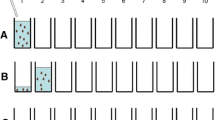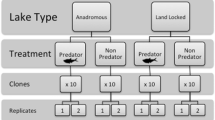Abstract
Here we test for the possible coupling of two kairomone-induced, anti-fish defences in Daphnia, life-history changes (LHC) and diel vertical migration (DVM) mediated by the environmental factor light. A gradient of five different light intensities that represents naturally occurring intensities in the lake water column was used in life-history experiments, and we show that LHC of a single Daphnia clone are inversely coupled to the ambient light intensity. Furthermore, we could show that the light intensity has to exceed a threshold to induce the LHC. We also observed an effect of the light intensity on the fish kairomone-mediated expression of a candidate gene (actin 3) in a way that the gene response differs between groups of low and high light intensities. We argue that the ambient light intensity an individual is exposed to and that is dependent on the position in the water column of a lake inversely determines the degree of LHC. These findings suggest a plastic coupling of these two anti-fish defences in Daphnia (LHC and DVM), which allows for an adjustment to fluctuating environments of standing freshwater ecosystems.



Similar content being viewed by others
References
Agrawal, A. A., C. Laforsch & R. Tollrian, 1999. Transgenerational induction of defences in animals and plants. Nature 401: 60–63.
Boersma, M., P. Spaak & L. De Meester, 1998. Predator-mediated plasticity in morphology, life history, and behavior of Daphnia: the uncoupling of responses. American Naturalist 152: 237–248.
Brooks, J. L. & S. I. Dodson, 1965. Predation, body-size and composition of plankton. Science 150: 28–35.
Cousyn, C., L. De Meester, J. K. Colbourne, L. Brendonck, D. Verschuren & F. Volckaert, 2001. Rapid, local adaptation of zooplankton behavior to changes in predation pressure in the absence of neutral genetic changes. Proceedings of the National Academy of Sciences of the United States of America 98: 6256–6260.
De Meester, L., J. Vandenberghe, K. Desender & H. J. Dumont, 1994. Genotype-dependent daytime vertical-distribution of Daphnia magna in a shallow pond. Belgian Journal of Zoology 124: 3.
Dodson, S. I., 1989. Predator-induced reaction norms. BioScience 39: 447–452.
Effertz, C. & E. Von Elert, 2014. Light intensity controls anti-predator defences in Daphnia: the suppression of life-history changes. Proceedings of the Royal Society B - Biological Sciences 281: 20133250.
Effertz, C., S. Muller & E. Von Elert, 2015. Differential Peptide Labeling (iTRAQ) in LC-MS/MS based proteomics in Daphnia reveal mechanisms of an antipredator response. Journal of Proteome Research 14: 888–896.
Gliwicz, Z. M., 1986. Predation and the evolution of vertical migration in zooplankton. Nature 320: 746–748.
Harvell, C. D., 1990. The ecology and evolution of inducible defenses. Quarterly Review of Biology 65: 323–340.
Heckmann, L. H., R. Connon, T. H. Hutchinson, S. J. Maund, R. M. Sibly & A. Callaghan, 2006. Expression of target and reference genes in Daphnia magna exposed to ibuprofen. BMC Genomics 7: 175.
Lampert, W., 1989. The adaptive significance of diel vertical migration of zooplankton. Functional Ecology 3: 21–27.
Lampert, W., 1994. Chemische Induktion von Verteidigungsmechanismen bei Süsswassertieren. Naturwissenschaften 81: 375–382.
Lampert, W. & K. O. Rothhaupt, 1991. Alternating dynamics of rotifers and Daphnia magna in a shallow lake. Archiv für Hydrobiologie 120: 447–456.
Larsson, P. & S. I. Dodson, 1993. Invited review: chemical communication in planktonic animals. Archiv für Hydrobiologie 129: 129–155.
Loose, C. J., 1993. Lack of endogenous rhythmicity in Daphnia diel vertical migration. Limnology and Oceanography 38: 1837–1841.
Loose, C. J., E. Von Elert & P. Dawidowicz, 1993. Chemically induced diel vertical migration in Daphnia: a new bioassay for kairomones exuded by fish. Archiv für Hydrobiologie 126: 329–337.
Magurran, A. E., B. H. Seghers, G. R. Carvalho & P. W. Shaw, 1992. Behavioral consequences of an artificial introduction of guppies (Poecilia reticulata) in N-Trinidad: evidence for the evolution of antipredator behavior in the wild. Proceedings of the Royal Society B – Biological Sciences 248: 117–122.
Otte, K. A., T. Froehlich, G. J. Arnold & C. Laforsch, 2014. Proteomic analysis of Daphnia magna hints at molecular pathways involved in defensive plastic responses. BMC Genomics 15: 306.
Pijanowska, J. & M. Kloc, 2004. Daphnia response to predation threat involves heat-shock proteins and the actin and tubulin cytoskeleton. Genesis: the Journal of Genetics & Development 38: 81–86.
Ringelberg, J., B. J. G. Flik, D. Lindenaar & K. Royackers, 1991. Diel vertical migration of Daphnia hyalina (sensu latiori) in Lake Maarsseveen: Part 1. Aspects of seasonal and daily timing. Archiv für Hydrobiologie 121: 129–145.
Sakwinska, O. & P. Dawidowicz, 2005. Life history strategy and depth selection behavior as alternative antipredator defenses among natural Daphnia hyalina populations. Limnology and Oceanography 50: 1284–1289.
Schwarzenberger, A., C. Courts & E. Von Elert, 2009. Target gene approaches: gene expression in Daphnia magna exposed to predator-borne kairomones or to microcystin-producing and microcystin-free Microcystis aeruginos. BMC Genomics 10: 527.
Seeley, R. H., 1986. Intense natural-selection caused a rapid morphological transition in a living marine snail. Proceedings of the National Academy of Sciences of the United States of America 83: 6897–6901.
Stibor, H., 2002. The role of yolk protein dynamics and predator kairomones for the life history of Daphnia magna. Ecology 83: 362–369.
Stibor, H. & J. Lüning, 1994. Predator-induced phenotypic variability in the pattern of growth and reproduction in Daphnia hyalina (Crustacea: Cladocera). Functional Ecology 8: 97–101.
Stibor, H. & J. Machacek, 1998. The influence of fish-exuded chemical signals on the carbon budget of Daphnia. Limnology and Oceanography 43: 997–1000.
Stich, H. B. & W. Lampert, 1981. Predator evasion as an explanation of diurnal vertical migration by zooplankton. Nature 293: 396–398.
Storz, U. C. & R. J. Paul, 1998. Phototaxis in water fleas (Daphnia magna) is differently influenced by visible and UV light. Journal of Comparative Physiology A – Sensory Neural and Behavioral Physiology 183: 709–717.
Tilzer, M. M., N. Stambler & C. Lovengreen, 1995. The role of phytoplankton in determining the underwater light climate in Lake Constance. Hydrobiologia 316: 161–172.
van Gool, E. & J. Ringelberg, 1997. The effect of accelerations in light increase on the phototactic downward swimming of Daphnia and the relevance to diel vertical migration. Journal of Plankton Research 19: 2041–2050.
van Gool, E. & J. Ringelberg, 1998a. Light-induced migration behaviour of Daphnia modified by food and predator kairamones. Animal Behaviour 56: 741–747.
van Gool, E. & J. Ringelberg, 1998b. Quantitative effects of fish kairomones and successive light stimuli on downward swimming responses of Daphnia. Aquatic Ecology 32: 291–296.
van Gool, E. & J. Ringelberg, 2003. What goes down must come up: symmetry in light-induced migration behaviour of Daphnia. Hydrobiologia 491: 301–307.
Von Elert, E. & F. Jüttner, 1997. Phosphorus limitation not light controls the exudation of allelopathic compounds by Trichormus doliolum. Limnology and Oceanography 42: 1796–1802.
Von Elert, E. & C. J. Loose, 1996. Predator-induced diel vertical migration in Daphnia – enrichment and preliminary chemical characterization of a kairomone exuded by fish. Journal of Chemical Ecology 22: 885–895.
Von Elert, E. & H. Stibor, 2006. Predator-mediated life history shifts in Daphnia: enrichment and preliminary chemical characterisation of a kairomone exuded by fish. Archiv für Hydrobiologie 167: 21–35.
Wacker, A. & E. Von Elert, 2001. Polyunsaturated fatty acids: evidence for non-substitutable biochemical resources in Daphnia galeata. Ecology 82: 2507–2520.
Weider, L. J. & J. Pijanowska, 1993. Plasticity of Daphnia life histories in response to chemical cues from predators. Oikos 67: 385–392.
Williamson, C. E., J. M. Fischer, S. M. Bollens, E. P. Overholt & J. K. Breckenridge, 2011. Toward a more comprehensive theory of zooplankton diel vertical migration: integrating ultraviolet radiation and water transparency into the biotic paradigm. Limnology and Oceanography 56: 1603–1623.
Wissel, B. & C. W. Ramcharan, 2003. Plasticity of vertical distribution of crustacean zooplankton in lakes with varying levels of water colour. Journal of Plankton Research 25: 1047–1057.
Acknowledgements
We thank P. Fink, M. Christjani, J. Mölzner and T. Sadler for their helpful comments on earlier drafts of the manuscript and Jacqueline Lange for her help with the experiments.
Author information
Authors and Affiliations
Corresponding author
Ethics declarations
Conflict of interest
The authors declare no conflict of interest.
Additional information
Guest editors: Adam Petrusek & Piet Spaak / Proceedings of the 10th International Symposium on Cladocera
Rights and permissions
About this article
Cite this article
Effertz, C., von Elert, E. Coupling of anti-predator defences in Daphnia: the importance of light. Hydrobiologia 798, 5–13 (2017). https://doi.org/10.1007/s10750-015-2387-x
Received:
Revised:
Accepted:
Published:
Issue Date:
DOI: https://doi.org/10.1007/s10750-015-2387-x




